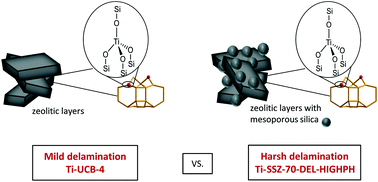当前位置:
X-MOL 学术
›
React. Chem. Eng.
›
论文详情
Our official English website, www.x-mol.net, welcomes your feedback! (Note: you will need to create a separate account there.)
Epoxidation of 1-octene under harsh tail-end conditions in a flow reactor II: impact of delaminated-zeolite catalyst surface area and structural integrity on catalytic performance†
Reaction Chemistry & Engineering ( IF 3.9 ) Pub Date : 2017-10-12 00:00:00 , DOI: 10.1039/c7re00138j Martina Aigner 1, 2, 3, 4 , Nicolás Andrés Grosso-Giordano 1, 2, 3, 4 , Christian Schöttle 1, 2, 3, 4 , Alexander Okrut 1, 2, 3, 4 , Stacey Zones 4, 5, 6 , Alexander Katz 1, 2, 3, 4
Reaction Chemistry & Engineering ( IF 3.9 ) Pub Date : 2017-10-12 00:00:00 , DOI: 10.1039/c7re00138j Martina Aigner 1, 2, 3, 4 , Nicolás Andrés Grosso-Giordano 1, 2, 3, 4 , Christian Schöttle 1, 2, 3, 4 , Alexander Okrut 1, 2, 3, 4 , Stacey Zones 4, 5, 6 , Alexander Katz 1, 2, 3, 4
Affiliation

|
Building on our previous study of delaminated-zeolite catalysts for harsh tail-end conditions in an epoxidation flow reactor employing organic hydroperoxide as oxidant, this manuscript compares approaches for delamination in catalyst prepration. In one, a mild method of delamination is used for synthesis of Ti-UCB-4, in which fluoride in organic solvent is used as a mineralizing agent to affect delamination, while in another, catalyst Ti-SSZ-70-DEL-HIGHPH is synthesized by delamination under high-pH conditions and results in the highest external surface area, similar to that previously reported for ITQ-2. We also compare both materials to the calcined 3-D zeolite consisting of Ti-SSZ-70, a control which underwent no delamination treatment. Results of long-term flow reactor catalytic testing demonstrate a distinct 2.5-fold increase in reaction-rate constant k′ on a mass basis for Ti-UCB-4 relative to 3-D Ti-SSZ-70, and a lack of long-term deactivation for both catalysts. In contrast, for Ti-SSZ-70-DEL-HIGHPH, due to deactivation, no steady-state behavior is observed for either conversion or selectivity with increasing times on stream. A combination of data from powder X-ray diffraction (PXRD), nitrogen physisorption at 77 K, high-angle annular dark-field scanning transmission electron microscopy (HAADF-STEM), and UV-visible (UV-vis) spectroscopy demonstrate Ti-SSZ-70-DEL-HIGHPH to be comprised of a combination of crystalline and amorphous phases. Control experiments demonstrate a negative synergy on catalysis when both phases are combined in a single catalyst, which leads to decreased conversion, at levels below values predicted based on the linear combination of the two phases present.
中文翻译:

在流动反应器中,在苛刻的尾端条件下,1-辛烯的环氧化反应II:脱层沸石催化剂表面积和结构完整性对催化性能的影响†
基于我们先前在苛刻的尾端条件下使用有机氢过氧化物作为氧化剂的脱层沸石催化剂在苛刻尾端条件下的研究,该手稿比较了催化剂制备中脱层的方法。一种方法是使用温和的分层方法合成Ti-UCB-4,其中将有机溶剂中的氟化物用作矿化剂以影响分层,而另一种方法是将催化剂Ti-SSZ-70-DEL-HIGHPH通过在高pH条件下分层而合成,并得到最高的外表面积,这与先前报道的ITQ-2相似。我们还将这两种材料与由Ti-SSZ-70组成的煅烧3-D沸石(未经过分层处理的对照)进行了比较。长期流动反应器催化测试的结果显示出明显的不同2。ķTi-UCB-4相对于3-D Ti-SSZ-70的质量',并且两种催化剂均缺乏长期失活。相比之下,对于Ti-SSZ-70-DEL-HIGHPH,由于失活,转化率或选择性随流逝时间的增加而未观察到稳态行为。粉末X射线衍射(PXRD),77 K下的氮物理吸附,高角度环形暗场扫描透射电子显微镜(HAADF-STEM)和紫外可见(UV-vis)光谱数据的组合表明,Ti- SSZ-70-DEL-HIGHPH由结晶相和非晶相组成。对照实验表明,当两相合并在一个催化剂中时,催化作用会产生负协同作用,导致转化率降低,其水平低于根据存在的两相的线性组合预测的值。
更新日期:2017-10-12
中文翻译:

在流动反应器中,在苛刻的尾端条件下,1-辛烯的环氧化反应II:脱层沸石催化剂表面积和结构完整性对催化性能的影响†
基于我们先前在苛刻的尾端条件下使用有机氢过氧化物作为氧化剂的脱层沸石催化剂在苛刻尾端条件下的研究,该手稿比较了催化剂制备中脱层的方法。一种方法是使用温和的分层方法合成Ti-UCB-4,其中将有机溶剂中的氟化物用作矿化剂以影响分层,而另一种方法是将催化剂Ti-SSZ-70-DEL-HIGHPH通过在高pH条件下分层而合成,并得到最高的外表面积,这与先前报道的ITQ-2相似。我们还将这两种材料与由Ti-SSZ-70组成的煅烧3-D沸石(未经过分层处理的对照)进行了比较。长期流动反应器催化测试的结果显示出明显的不同2。ķTi-UCB-4相对于3-D Ti-SSZ-70的质量',并且两种催化剂均缺乏长期失活。相比之下,对于Ti-SSZ-70-DEL-HIGHPH,由于失活,转化率或选择性随流逝时间的增加而未观察到稳态行为。粉末X射线衍射(PXRD),77 K下的氮物理吸附,高角度环形暗场扫描透射电子显微镜(HAADF-STEM)和紫外可见(UV-vis)光谱数据的组合表明,Ti- SSZ-70-DEL-HIGHPH由结晶相和非晶相组成。对照实验表明,当两相合并在一个催化剂中时,催化作用会产生负协同作用,导致转化率降低,其水平低于根据存在的两相的线性组合预测的值。



























 京公网安备 11010802027423号
京公网安备 11010802027423号